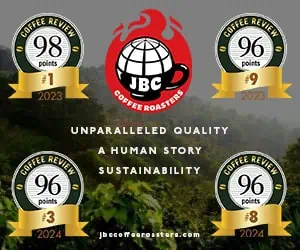With this espresso tasting we focus on what appears to be a new trend in espresso blending – the open disclosure to customer and competitor of the identity of the specific green coffees that compose a blend, as opposed to the deliberate secrecy around blending that has prevailed in the coffee industry for decades. The old approach to blending implied secret mastery of arcane coffee knowledge that only the blend master possessed, a mystification basically aimed at convincing consumers that a proprietary blend, with its evocative name and mysterious contents, was a singular sensory opportunity that could only be could be had through one company, the blender’s company, and not through any other. A collateral advantage to secret blend formulas might be saving money by slipping in some cheaper coffees along with the better ones while still maintaining the fundamental character of the blend.
On the other hand, when the components of a blend are openly disclosed, as they are in the twenty blends we tested for this article, the goal of blending is partly stripped of its branding and cost-savings functions. It becomes more clearly a creative sensory act, aimed at creating a coffee experience that has never existed before in quite the same way, one in which hopefully the sensory whole of the blend transcends the contributions of its parts. This is an idealistic coffee goal, but a worthy one.
Farther long in this piece I discuss some the trends and strategies suggested by the selection of green coffees in the blends we tested. But what I had not quite anticipated was how evocative overall these twenty blends would be in mapping some of the larger trends and polarizations in contemporary espresso blend design, at least as they are playing out in North America with a short detour through one coffee-loving East Asian country, Taiwan.
Co-Taster Ethan Hill, Barista Benjamin Roberts and the La Marzocco Lab
My co-taster for this survey was Ethan Hill, Head of Production at Victrola Coffee. (Victrola Coffee did not have coffees involved in the tasting, of course.) Ethan is a licensed Q-grader who proved to be an experienced and incisive taster and describer of espresso. See the end of this article for Ethan’s impressive bio. We conducted the tasting at the La Marzocco North America laboratory in Seattle, Washington, with shots pulled by the very experienced Victrola barista, Benjamin Roberts. We ended up tasting twenty “open source” espresso blends, seventeen from leading North American roasters ranging from very large to very small, and three from Taiwan-based roasting companies. We sourced over thirty blends, but were forced to limit our tasting to twenty owing to time constraints. Some blends we eliminated because roasters did not send us the minimum of sixteen ounces we need to calibrate the grinder, produce the shots, and take roast color readings afterwards. In other cases we made arbitrary inclusions or exclusions based on how interesting or original the blends sounded based on their constituent coffees.
The Crucial Starbucks Entry
One blend we did include was extremely important, I think, in understanding the entire exercise: the Starbucks Reserve Pantheon Blend No.1. This is a flagship blend roasted in very limited quantities on the small-batch roasting machine prominently displayed on the top level of the spectacular new Starbucks Reserve Roastery facility in Seattle. Like almost everything else involved in the new Starbucks showplace roastery, the Pantheon Blend displays a detailed, almost textbook-like understanding of the latest trends in specialty coffee. The Pantheon is clearly intended as a transparent, open-source blend of the newer kind. The blend name itself implies that this is the first in a series of seasonal blends (Pantheon Blend No. 1; presumably as green coffee opportunities change through the year we will have Pantheon Blends No. 2, No. 3, and so on). Furthermore, the constituents of this version #1 are revealed in considerable detail, in some cases in more detail than revealed by some of the smaller and presumably trendier roasters that produced other blends in the tasting.
Revelation by Contrast
However, as it turned out, the Starbucks blend differed in one dramatic way from all the other nineteen blends we tested: It was darker roasted than any of the others. Not nearly as dark roasted as some Starbucks coffees, but considerably darker roasted than any of the other nineteen samples in our tasting.
And by its mildly roasty presence in the mix the Pantheon Blend dramatized through contrast how relatively bright and high-toned most other high-end North American espresso blends have become in recent years. High-toned brightness obviously can be promoted in a couple of ways; first through a lighter roast style and second through incorporating bright, acidy coffees into blends: bright, floral wet-processed coffees from Ethiopia were one of the favorites in this set of blends, for example, as were wet-processed coffees from a variety of origins in Latin America. Balancing these brighter coffees were everyone’s favorite for achieving smoothness in espresso blends: nutty, chocolaty dried-in-the-fruit or “natural” coffees from Brazil. But also very important in many of these blends were the fruitier, sweeter style of dried-in-the-fruit coffees, particularly those from Ethiopia, which tend to add a juicy, sometimes slightly fermenty fullness to espresso blends. Now and then a robust, presumably earth- or cedar-toned wet-hulled Sumatra put in an appearance as a foil to the brighter wet-processed coffees, but there were far fewer Sumatras than there might have been some years ago when espresso blends were roasted darker and the pungent, woodsy contribution of Sumatras was more valued.
Favored Sweet Spots in the Roast
In respect to final degree or darkness of roast there appeared to be two main “sweet spots” for the creators of these blends. One was just at the very first hint of the “second crack” which signals the transition from medium to darker roast. Of the eleven blends we reviewed at 92 or higher, three were brought to this subtly pivotal point in roast development. Two of them were roasted in Taiwan – Simon Hsieh’s Proud Goat Espresso Blend (93) and the Mellow Coffee Dawning Espresso (92) – and one in the States, the Tony’s Coffees & Teas Ganesha Espresso (92).
However, it appears that the favorite settling spot for final roast color among the North American blends we reviewed was a classic medium roast, roughly where sugars and aromatics are well developed but before any hint of pungent roast taste puts in an appearance. Six of the eleven 92-plus blends, including the top-rated Taiwanese Bignose Espresso (94), roughly fell into the classic medium-roast category.
Roast-Level Outliers
The two outliers in roast development among the eleven reviewed coffees were the Starbucks Pantheon Blend, which showed a distinct dark roast pungency and which by machine reading of roast color was brought to the cusp between dark and medium dark, and the Bonlife Top Shelf Espresso, which, for an espresso, was very light roasted, medium-light to light.
My co-taster Ethan generally appeared to take a more critical position toward the impact of roast than I did; he was considerably more critical of the Starbucks than I was, for example, although he still assigned it a rating of 91. Three or four of the blends that we did not review struck him as too sharp, bitter and/or tart; in these cases my ratings often came in modestly higher than his did.
A New North-American Norm?
At any rate, these espresso blends did suggest a certain overall trend, a new norm perhaps for North American espresso blends: bright but not too bright, medium-roasted, with a balance of moderately acidy wet-processed coffees, round, nut-toned Brazils, and juicy natural, dried-in-the-fruit Ethiopias. Although they did not appear to be optimized for drinking as a cappuccino or other short milk drink, most did show well in cappuccino-scaled milk, softening but maintaining character. And, of course, given the new openness around blend communication, we now have an opportunity to know and appreciate some of the coffee thinking that went into their production and subtle differences.
Final Thanks To …
Co-taster Ethan Hill, Victrola barista Benjamin Roberts, who skillfully dialed in and pulled every espresso shot for the tasting, and La Marzocco North America for the use of its superb lab and equipment, including the support of KEXP Project Manager Amy Hattemer and her staff (not to mention their excellent recommendations for lunch).
About this Month’s Co-Cupper
Ethan Hill is the Head of Production and Quality Control at Victrola Coffee Roasters in Seattle, WA. He was raised on a six-acre coffee farm in the Puna district of the Big Island of Hawaii. He co-founded Puna Moon Estate Coffees in 1995 and the Hilo Coffee Mill – East Hawaii’s first full-service roastery and coffee mill – in 1999. He has over ten years of roasting experience, having served as Production Roaster for Hilo Coffee Mill, Head Roaster for Rimini Coffee Inc. in Salt Lake City, Utah, and Head of Production for Victrola Coffee Roasters. He has taught coffee-related courses on a variety of topics for the University of Utah and the Specialty Coffee Association of America. He is a licensed Q-Grader. He reports: “I was thrilled to serve as a sensory analyst for Coffee Review’s Open-Source Espresso Blends article, and to contribute my thoughts and impressions to the article. It was exciting to see such a wide range of flavor profiles in the espresso submissions. I was particularly struck by how blends that ended up scoring the same rating were so dramatically different from one another.”











